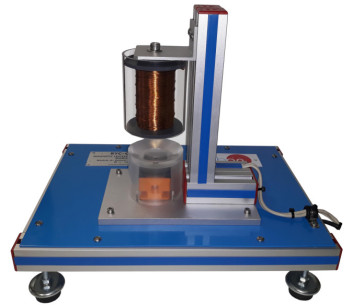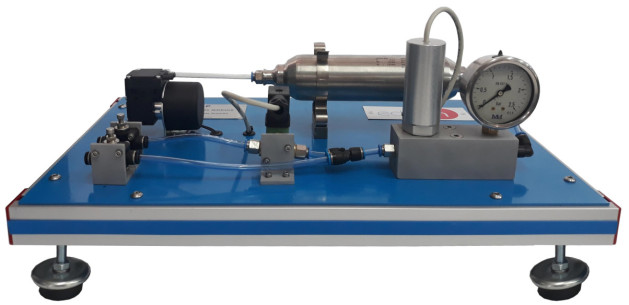RYC Peralatan untuk Studi Regulasi dan Kontrol, Dikendalikan dari Komputer (PC)
SISTEM INOVATIF
Regulation and control theory is divided into two major divisions in, namely, classical and modern. The implementation of classical controller designs as compared to systems designed using modern control theory is easier and these controllers are preferred in most industrial applications. The most common controllers designed using classical control theory, are PID controllers.
Ekspansi
Laboratorium
BERITA TERKAIT
GAMBARAN UMUM
Regulation and control theory is divided into two major divisions in, namely, classical and modern. The implementation of classical controller designs as compared to systems designed using modern control theory is easier and these controllers are preferred in most industrial applications. The most common controllers designed using classical control theory, are PID controllers.
The Computer Controlled Teaching Unit for the Study of Regulation and Control, "RYC", allows the students to simulate an integrator system, a first order system and a second order system and regulate them with a PID controller or Lead and Lag compensator. The unit also allows to simulate perturbations and offsets to analyze the response of the system.
A wide range of applications: DC Servo Motor Module, Ball and Beam Module, etc. for working with the "RYC" unit are available to study a real control systems response to complement the Study of regulation and control in real time.
LATIHAN DAN PRAKTEK PEDOMAN
LATIHAN PRAKTIS YANG DIANDAL TERMASUK DALAM PANDUAN
- Response of a first order system in time domain. (Step response).
- Response of a first order system in time domain. (Ramp response).
- Response of a first order system in time domain. (Sine response).
- Response of a first order system in frequency domain. (Sine response).
- Response of a second order system in time domain. (Step response).
- Response of a second order system in time domain. (Ramp response).
- Response of a second order system in time domain. (Sine response).
- Response of a second order system in frequency domain. (Sine response).
- Phase Lead Compensator experiment.
- Phase Lag Compensator experiment.
- Structure of a PID controller. (Proportional-Integrative-Derivative blocks).
- PID control of a first order system in open-loop.
- PID control of a second order system in open-loop.
- PID control of a first order system in closed-loop. (Mathematical tuning).
- PID control of a first order system in closed-loop. (Experimental tuning).
- PID control of a first order system in closed-loop. (Ziegler-Nichols tuning).
- PID control of a second order system in closed-loop. (Mathematical tuning).
- PID control of a second order system in closed-loop. (Experimental tuning).
- PID control of a second order system in closed- loop. (Ziegler-Nichols tuning).
LEBIH BANYAK LATIHAN PRAKTIS YANG AKAN DILAKUKAN DENGAN UNIT
- Many students view results simultaneously. To view all results in real time in the classroom by means of a projector or an electronic whiteboard.
- Open Control, Multicontrol and Real Time Control. This unit allows intrinsically and/or extrinsically to change the span, gains, proportional, integral, derivative parameters, etc, in real time.
- This unit is totally safe as uses mechanical, electrical and electronic, and software safety devices.
- This unit can be used for doing applied research.
- This unit can be used for giving training courses to Industries even to other Technical Education Institutions.
- Control of the RYC unit process through the control interface box without the computer.
- Visualization of all the sensors values used in the RYC unit process.
- Several other exercises can be done and designed by the user.
PERALATAN SIMILAR TERSEDIA
Unit Dasar untuk BS, Dikendalikan dari Komputer (PC)
PERALATAN KOMPLEMENTER
Peralatan Dasar Pengendalian dan Pengaturan PID
Peralatan Modular untuk Regulasi dan Kontrol, Dikendalikan dari Komputer (PC)
Peralatan Pengendalian dan Pengaturan PID untuk Sistem Batang-Bola
Peralatan Pengendalian dan Pengaturan Servomotor DC dengan PID
Peralatan Pengendalian dan Pengaturan Suhu Aliran Udara dengan PID
Peralatan Pengendalian dan Pengaturan PID Pendulum Terbalik
Peralatan Pengendalian dan Pengaturan Levitasi Magnetik dengan PID
Peralatan Pengendalian dan Pengaturan Suhu Aliran Air dengan PID
Peralatan Pengendalian dan Pengaturan Suhu dengan PID
Peralatan Pengendalian dan Pengaturan PID untuk Tingkat Tekanan
Peralatan Pengendalian dan Pengaturan Ketinggian dengan PID
Peralatan Pengendalian dan Pengaturan Aliran dengan PID
KUALITAS

LAYANAN PURNA JUAL

 Preferensi cookie
Preferensi cookie




























